
Now that we’re already five months into the year and summer is quickly approaching, it’s time we revisit some of the digital marketing trends we’ve been keeping our eye on — particularly those that relate to the solar industry.
As a follow-up to last week’s webinar about key marketing trends in the solar industry, here are five major trends you should be aware of if you are a solar contractor.
Messaging for the Federal Tax Credit Step Down
As a solar contractor, you’re well aware of the Federal Investment Tax Credit (ITC) and how that 30% deduction for solar PV systems will drop to 26% after this year. If you’re not already putting out messaging about the Federal Solar Tax Credit step down, then you definitely should be.
We recommend placing your messaging in prominent areas on your website, such as near your primary call-to-action or in its own section on the home page.
On the Sky Power Solar website, for example, there is an educational section about the Solar Tax Credit step down right below the contact form on the home page:
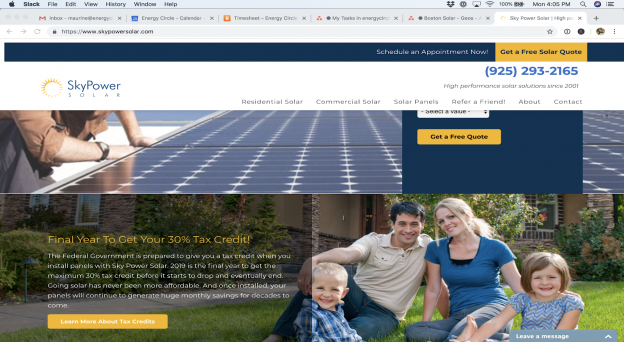
Sky Power Solar places important messaging about the Federal ITC just below the contact form on their home page.
You might also consider creating an explainer video about the Federal ITC or writing a blog post that explains the advantages of installing solar in 2019.
Keep in mind that some forms of messaging may infer that all federal tax incentives for solar will disappear after this year; so you want to be clear. For best practices, make sure you’re 1) educating your customer base, 2) creating some form of urgency, and 3) placing your messaging in a prominent area where your audience is sure to see it.
Live Chat & What to Expect
Live chat continues to be on the rise in 2019, and we’re getting more questions from solar contractors like “What if I were to try this?” and “What can I expect?”
After surveying 135 Energy Circle websites over the past three years, we can say with surety that “instant gratification” forms of communication like phone and chat continue to grow more quickly than slower forms of communication like web forms and email. Clearly, people are demanding faster answers to the things that are on their mind.
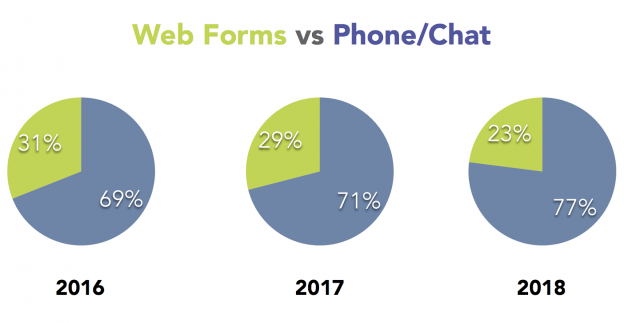
As of 2018, phone and chat contact methods (when compared to web forms) were utilized at a rate of 77% — an increase in 8 percentage points from 2016.
As of 2018, phone and chat contact methods (when compared to web forms) were utilized at a rate of 77% — an increase in 8 percentage points from 2016.
Considering chat for your solar company but aren’t sure what to expect? Here are the numbers we saw with one particular solar contractor:
-
About 20 chat sessions per month
-
Chat sessions made up 7–18% of overall leads
-
45% of chat sessions were people looking for quotes and assessments
-
55% of chat sessions involved more general questions
Of course, we cannot be sure how many of these chat leads would have been phone leads had chat not been an available contact method. That said, chat does seem to bring a lot of customer satisfaction, and it could boost your lead generation efforts when offered as an additional contact option.
Growing Importance of Google My Business
We’ve talked at length about how your Google My Business (GMB) profile is like your second home page. You can feed a lot of information about your company into GMB, and Google aggregates a lot of information into it, as well. Meanwhile, Google continues to add more interactive features to GMB, and people are using company profiles to make phone calls.
In fact, for one of our clients — a large, well known solar company — we found through call tracking that 49% of all web originated phone calls originated directly from the GMB profile.
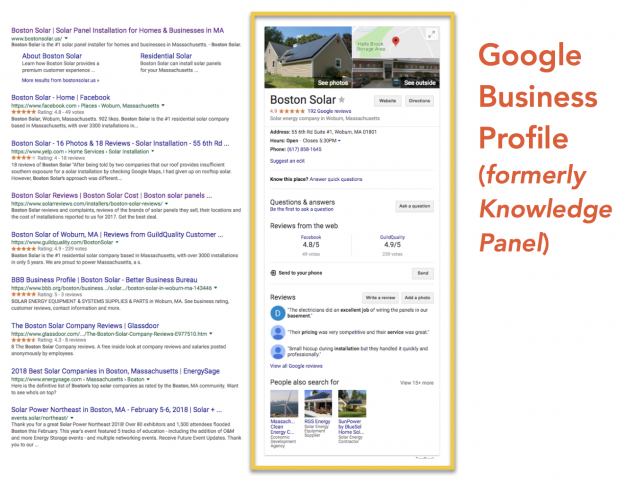
The Google My Business profile, formerly known as the Knowledge Panel, has a growing number of interactive features and is frequently used as the first point of contact.
The Google My Business profile, formerly known as the Knowledge Panel, has a growing number of interactive features and is frequently used as the first point of contact.
Here are a few tips on optimizing your GMB profile:
Update your GMB category
For a long time, the best business category solar contractors had to choose from on GMB was “solar energy equipment supplier.” Now, you may choose “solar energy company” or “solar energy contractor” as your primary category. We’re still testing which of these two categories performs better, but we recommend choosing “solar energy contractor” because it infers that you provide solar panel installation.
Aim for 75+ Google reviews
As online reviews continue to become a stronger ranking factor, it’s even more important to grow the number of reviews you’re earning on Google and other review sites. While having a couple dozen reviews was once enough to give you an edge over other solar contractors, that threshold is quickly rising. Now, we recommend that solar contractors garner at least 75 Google reviews.
Use Google Posts
We’ve also seen some notable success with solar contractors who use the GMB Google Posts feature. This Facebook post-like feature allows you to share blog posts, specials, awards, news, and more with your target audience, and it can offer somewhat of a ranking boost.
Google Posts is just one example of the kinds of things that Google has been adding to GMB for more interaction. While your GMB info may be up to date, be sure to ask yourself: “Am I encouraging target customers to engage with my company using my GMB profile?”
Competing with Solar Reviews
For almost all solar brand searches, Solar Reviews is the second or third result on the SERP — often the first listing immediately after the company website. While this isn’t necessarily a bad thing, keep in mind that clicks to Solar Reviews have an associated cost. Therefore, it may be advantageous to prioritize leads from other sources.
If Solar Reviews ranks highly for you, here are some things you can do to move it down the page:
Get sitelinks
Sitelinks are the subpages listed underneath your primary page on a SERP. While you cannot tell Google to display these, you can usually get them to appear by having a well structured website.
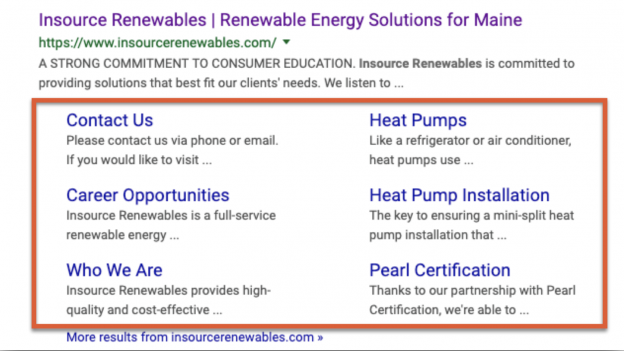
Having a well structured website allows subpages to display on SERPs, giving your website more real estate.
Be active on Facebook
Maintaining an active Facebook page by posting regularly and engaging with people in comments can give bump your Facebook profile higher in branded search results.
Have an active YouTube channel
The same goes for having an active YouTube channel. Posting videos on your YouTube channel regularly — whether they are brand oriented, educational, testimonials, or case studies — can give videos significant real estate on the SERP.
SEO Tip: make sure to enable closed captions in your YouTube videos! Captions are crawlable, and can give your videos the edge on a competing video of the same topic.
Be active on Yelp
While of course maintaining a strong Yelp presence comes with its own review management challenges, more engagement on Yelp gives your Yelp profile a higher ranking on SERPs.
Set GMB Up for Multiple Locations
If your company has multiple locations, make sure that you have GMB set up for each location. When done correctly, this will display a map of the multiple locations your company has near the top of the SERP.
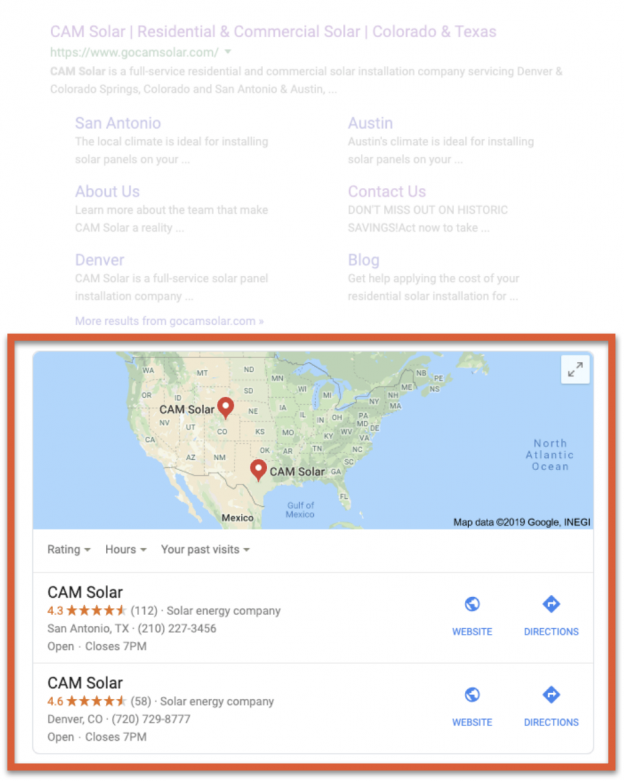
If your business has multiple locations, setting GMB up for each location will display a map of your locations in branded search results.
Optimizing for Project Sunroof Leads
You’re likely well aware of Project Sunroof, which launched in 2015 as a customer educator tool and a monetized lead generation tool for solar contractors. In 2017, Google ended the lead generation side of Project Sunroof and updated it to instead point users to solar companies on Google’s main search pages.
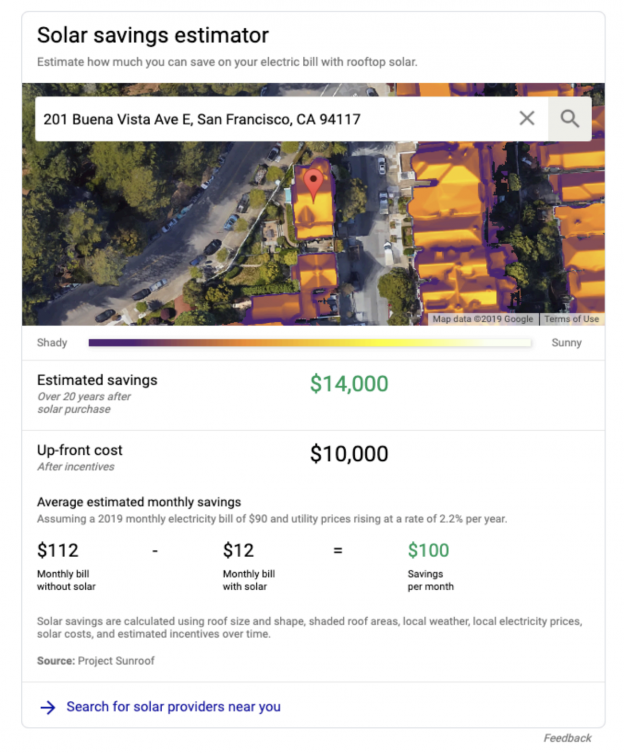
While Google’s Project Sunroof once displayed paid partner listings, it now points users to search results.
Key in this update is the feature which points users to search results. Clicking on “Search for solar providers near you” brings up a localized SERP for “solar providers near me,” including Local Pack listings.
While “solar provider” may not be a term that you use to describe yourself, its use in this Project Sunroof feature means you should optimize your website for the keyword “solar provider.” By optimizing for “solar provider” and following best practices for ranking in the Local Pack, you can increase your chances of capturing leads from Project Sunroof.